For Fri. 1/24 (for discussion):
For Mon. 1/27 (for discussion):
Hand in Wed. 1/29:
HOMEWORK II (1/22)
For Wed. 1/29:
For Thurs. 1/30:
For Fri. 1/31:
Hand in Mon. 2/3:
HOMEWORK III (1/31)
For Mon. 2/3:
For Thurs. 2/6 (for discussion):
For Fri. 2/7 (for discussion):
Hand in Mon. 2/10:
Problem Set A
A1. Show that if G is a graph that has a subgraph H, and H is not bipartite, then G is not bipartite.
A2. Suppose G is a simple graph of order n, V = {v1,v2,...,vn} is its vertex set, and A is its adjacency matrix. Show that, for any length m>0, the number of walks of length m from vi to vj equals the (i,j) entry of A^m.
A3. (Advanced problem, for those who are interested.) Let G be any graph. Define a relation on its vertex set V by v ~ w if there is a path from v to w.
- Prove that ~ is an equivalence relation.
- Prove that v ~ w if and only if v and w are in the same component of G (using the book's definition of component).
- Prove that G is connected if and only if ~ has just one equivalence class.
HOMEWORK IV (2/7)
For Mon. 2/10:
For Thurs. 2/13 (for discussion):
For Fri. 2/14 (for discussion):
Hand in Mon. 2/17:
Don't overlook the corrections!
Problem Set B
B1. Prove Corollary 6.3.
B2. Prove Corollary 6.4.
B3. Find another method, different from Fleury's, to generate an Eulerian trail.
B4. Find out exactly what's wrong with Exercise 5.8(ii) and, if you can, find a corrected version.
B5. Define Sn = {1,2,3,...,n}.
Now, G is the graph defined as follows: the vertex set consists of all 3-element subsets of S10 , that is,
and two vertices X and Y are adjacent if and only if they are disjoint, that is, (X intersect Y) = null set. Is G connected?
B6. In each graph, find a Hamilton cycle or prove there is none.
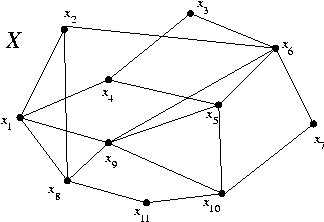
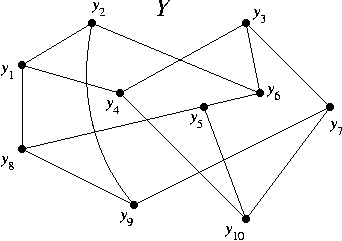
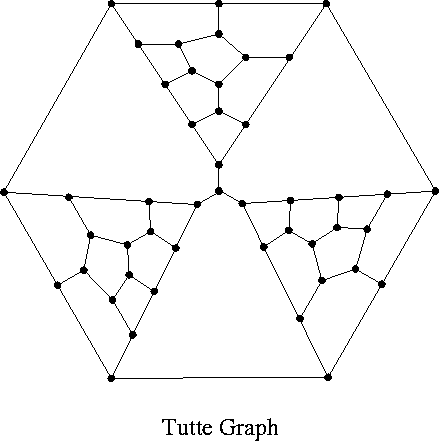
HOMEWORK V (2/7)
For Mon. 2/17:
For Wed. 2/19 (for discussion):
Also, review for Test I.
HOMEWORK VI (2/21)
For Mon. 2/24:
For Thurs. 2/27 (for discussion):
For Fri. 2/28 (for discussion):
Hand in Mon. 3/3:
Problem Set C
- Find all unlabelled trees (that means: isomorphic trees are considered to be the same) on n vertices for n = 1, 2, ..., 5.
- Find a cycle in the Petersen graph by using the method of Lemma 6.1 . This means to go through the details of the proof of the lemma, using the method (not in a clever way) to eventually wind up with a cycle.
- Prove: Proposition. A forest is a simple graph.
HOMEWORK VII (2/21)
For Mon. 3/3:
For Thurs. 3/6:
For Fri. 3/7:
Hand in Mon. 3/17:
Problem Set D
- Hamiltonicity:
- Show that H has a unique Hamiltonian cycle.
- Find all edges e such that H-e has no Hamiltonian cycle.
- Planarity:
- Decide whether H is planar.
- Let H' be H with the edges x6x7 and x10x12 added. Decide whether H' is planar. Use two different methods if you can find the time.
The problems refer to the graph H shown.
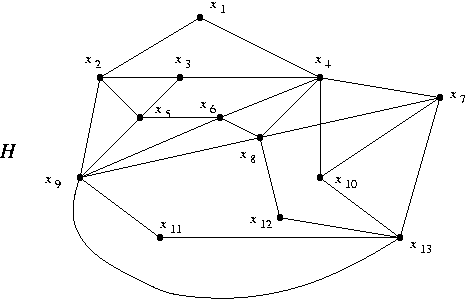
HOMEWORK VIII (3/6)
For Mon. 3/17:
For Thurs. 3/20:
For Fri. 3/21:
Hand in Mon. 3/24:
HOMEWORK IX (3/28)
For Mon. 3/31:
For Thurs. 4/3:
For Fri. 4/4:
Hand in Mon. 4/7:
HOMEWORK X (3/28)
For Mon. 4/7:
For Thurs. 4/10:
For Fri. 4/11:
Hand in Mon. 4/14:
Problem Set E
- Use the inductive method of the proofs of Theorems 17.1 and 17.3 to actually color the graph G in 5 colors.
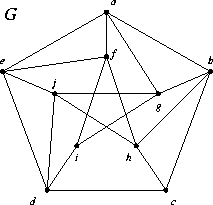
HOMEWORK XI (4/11)
For Mon. 4/14:
For Wed. 4/18:
HOMEWORK XII (4/11)
For Wed. 4/23:
For Fri. 4/25:
For Mon. 4/28:
Hand in Mon. 4/28:
Problem Set F
- Find the chromatic number of the ``clock'' graph G defined by
- V(G) = {1,2,...,12},
- E(G) = { {i,i+1}, {i,i+3}, {i,i+6} : i = 1,2,...,12 },
where in computing i+1, etc., arithmetic is modulo 12; that is, we treat 13 as if it were 1, 14 as if it were 2, etc. - Prove: if every vertex of a graph has even degree, then every cutset has an even number of edges.
- Suppose G is a graph without loops. For a vertex v, define T = the set of all edges incident with v. Prove that there are cutsets D1, ..., Dk (where k >= 1) such that the cutsets are pairwise disjoint and their union is T.
HOMEWORK XIII (5/2)
For Mon. 5/5:
For Mon. 5/5:
For Wed. 5/7:
Hand in Wed. 5/7:
HOMEWORK XIV (5/2)
For Thurs. 5/8:
Problem Set G
- Deduce the undirected edge Menger's theorem 28.1 from the directed edge Menger's theorem 28.5.
- Theorem 28.5 is a digraph version of Theorem 28.1. Theorem 28.7 (see the statement and the associated definitions), which the author forgot to print, is a digraph version of Theorem 28.2.
- Verify Theorem 28.7 for each digraph in Figure 28.7.
- Deduce Theorem 28.2 from Theorem 28.7.
- Deduce Theorem 28.7 from Theorem 28.5.
- Find the chromatic number of the graph F. (Note: This is the corrected graph F that has no K4 subgraph.)
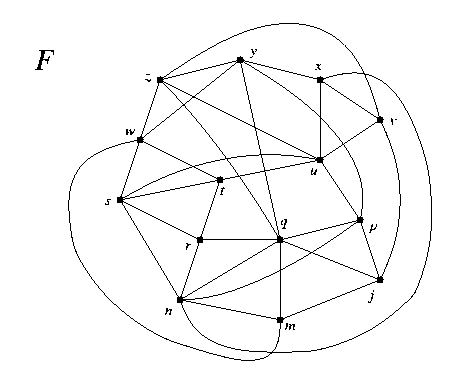
- Let G be a simple graph of order n >= 3 having m edges.
- Prove that cr(G) >= m - 3(n-2).
- If G has no triangles, then cr(G) >= m - 2(n-2).
- Let H = Kr,r - M where M is the edge set { xiyi : i = 1, 2, ..., r }. (Notation: The two bipartite vertex sets of Kr,r are V1 = { x1, x2, ..., xr } and V2 = { x1, x2, ..., xr } . The edges are xiyj for i, j = 1,2,...,r.)
- Find out as much as you can about the thickness t(H).
- Also find out as much as you can about cr(H).
- In the graph F, verify Menger's Theorems 28.1 and 28.2 between the vertices s and p. This means: find the number k which is both the largest number of edge-disjoint (for the vertex theorem, internally disjoint) sp-paths and the smallest number of edges (for the vertex theorem, vertices) whose removal disconnects s from p.
For additional practice, try other pairs of vertices. Each different pair is a different problem, so you can get a lot of practice from this one graph. - Let G be a simple graph of order n >= 3 having m edges.
General Advice on Homework
- Besides finding the anwer, always try to explain, as well as you can, how you know you have the correct answer.
- When solving problems, a systematic solution is better than guesswork. You often may find a solution by intelligent guessing, but then you should look for a way of showing that your solution is correct. This part needs to be systematic if it is to be completely convincing. (This will be clearer after a few days of class!)
- Allow 15 minutes per problem (minimum) before you give up, even if you feel you're getting nowhere. These problems need time for thought. If you're still stuck, go on to another problem. Return to the sticky problem later (say, the next day). Often, it then looks easier because you tried hard the first time and then gave your mind time to grind it up-I mean, to come up with ideas. To get the advantage of this method, you have to start the problems well ahead of time. Last-minute effort will not work well in this class.
- It's fine to work with other people, indeed I encourage it. However, you should write up your solutions yourself. Here's what you should do:
- Look at the problem first and think about it for at least a few minutes (preferably more--much more!).
- Discuss it with other people.
- Write up a solution in your own words. Don't copy from the notes of your discussion.
- If you have any question about the homework grading, you should see me promptly. Maybe you need me to explain something. Or maybe I made a mistake.
Rules for Hand-In Homework.
- I expect complete written solutions that give full justification of the correctness of your answer. Answers without any justification will not be accepted. You'll gradually learn better what this means, so don't worry now, just do your best to explain your work.
- Hand in a final draft: neat work that is well organized and not cramped. Use as much space as you need. Please also leave some extra space between problems for my comments.
- You may discuss hand-in HW with other people, but you must write it up in your own words.
- No little stubbies from tearing a page out of your binder. Remove them neatly, please!
- Fasten the pages securely. Staples are best. Paper clips and folding a corner don't hold well; don't use them.
Go to announcements | course information | syllabus.